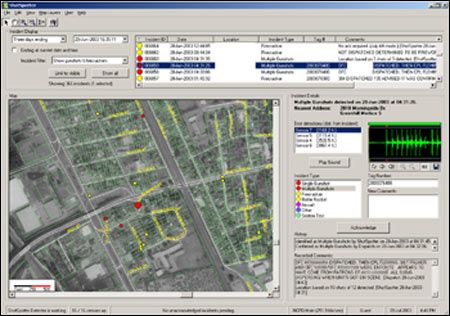By Marin Perez, Police1 Jr. Editor
In crime-ridden neighborhoods across the country, gunfire is an all-too-common sound. Worse yet, residents are often too jaded or scared to call 911.
 Screenshot of what a dispatcher would see with the ShotSpotter system. Screenshot of what a dispatcher would see with the ShotSpotter system. |
But now, with the help of cutting-edge gunfire detection systems like ShotSpotter, the sound itself can be enough for police to get a jump on criminals.
“It can give law enforcement a real tactical advantage,” said Gregg Rowland, Vice President of ShotSpotter, a company based in Mountain View, California. “Instead of relying on vague 911 calls — if the shots are even reported — an officer can respond with reliable intel.”
According to Rowland, the ShotSpotter gunshot detection system works via a mix of sensors, software and satellites. Screenshot of the ShotSpotter system.
Nondescript sensors are placed atop buildings and light poles (8-12 per square mile). These sensors detect all ambient noise, but recording only begins when an actual gunshot is fired. Of course, firecrackers and cars backfiring can sound awfully similar to gunfire. ShotSpotter picks these sounds up, but its proprietary filtering software has been fine-tuned to differentiate between actual shots and similar sounds.
“There isn’t much that can fool these babies,” Rowland said.
Once a shot is fired, the sound waves travel from the weapon to the three nearest sensors. The system uses “acoustic triangulation” — deduction based on the speed of sound — in conjunction with GPS to locate the shot, and the sensors then record and relay the information to the dispatch center. The dispatcher’s computer will show a red dot on a high-resolution map.
Using proprietary algorithms, the system can also determine if a shot is coming from a moving vehicle, as well as the speed of travel. Under ideal circumstances — nighttime and at a high dew point — ShotSpotter can pinpoint a shot to within three feet.
Within a minute of a discharged weapon, dispatchers can deploy officers with tactical knowledge of how many shots were fired, the approximate location of the discharged weapon, and a good idea of what type of weapon they’re facing.
“Officers sometimes arrive while the shooting is still going on,” said Rowland.
Celebrating with gunshots
The ShotSpotter system was first implemented in Redwood City, Calif. in 1996, when the small Northern California city was experiencing a deluge of celebratory gunfire. City leaders turned to Dr. Robert Showen and his then-named “Urban Gunshot Locator” in what was essentially a test installation.
“We went from 20 minutes of straight gunfire to a couple dozen gunshots the next year,” said Capt. Scott Warner, Redwood City PD, of the New Year’s Eve celebration. “And in the second year of the program, we had fewer than a dozen shots.”
The system worked, and Redwood City’s former police chief credited the it with helping achieve a 75 percent decrease in gunfire.
Since then, the ShotSpotter system has been installed in 20 cities across the United States, and is being used by the military for sniper detail. In the beginning, Rowland said, some departments shied away from it because it was new and unproven. But in 1997, the National Institute of Justice found the system to be effective and accurate, saying in an independent report that “the ShotSpotter [Gunshot Location System] accurately detected 80 % of test fire incidents inside the one square-mile coverage.”
According to Rowland, gunfire rates have been reduced — by 80 percent in some cases — and gunfire-related arrests have gone up in every city where ShotSpotter has been deployed.
“There is definitely a deterrent factor,” Rowland said. “If you make an arrest using ShotSpotter and then publicize it, it will make criminals think twice about shooting.”
The system is not foolproof, though. Under the worst-case scenario — daytime, with lots of ambient noise —accuracy can dip to 25 meters. Fully-suppressed weapons, shots fired indoors and very low-caliber weapons can also defeat the ShotSpotter system.
There is also the perception that the money spent on ShotSpotter could be better used on hiring more officers. But Rowland said most of the cities that have deployed ShotSpotter used federal grants or “rainy day money” to purchase it.
“I tell every department the same thing: ‘ShotSpotter isn’t going to make one arrest, but it will help your officers make plenty of them,’” he said.

